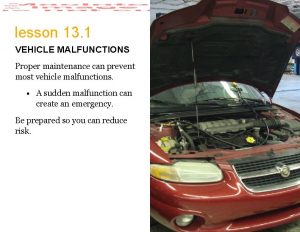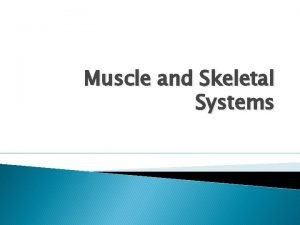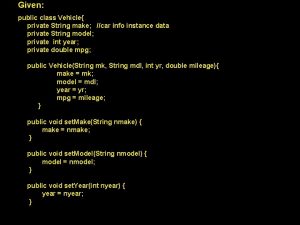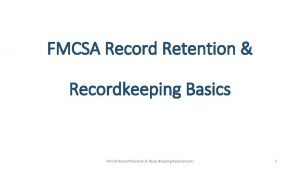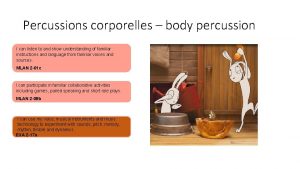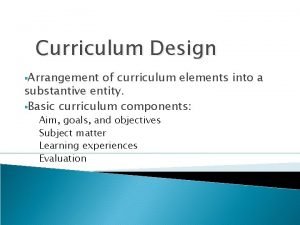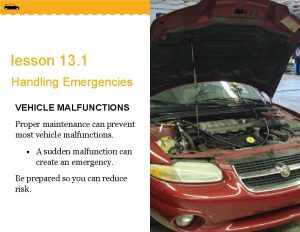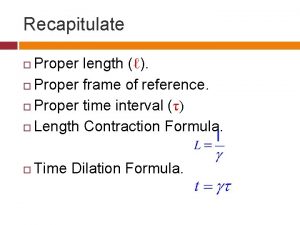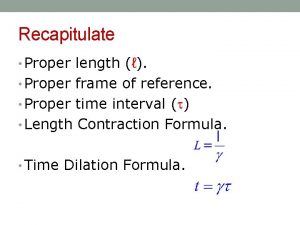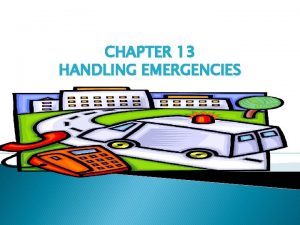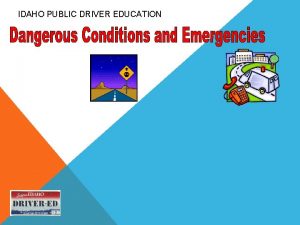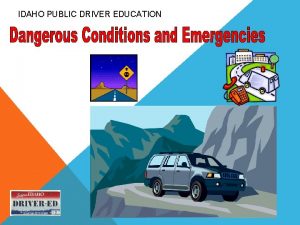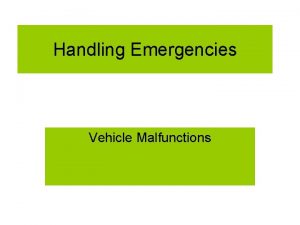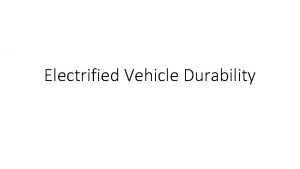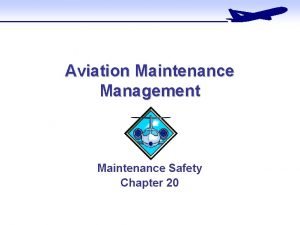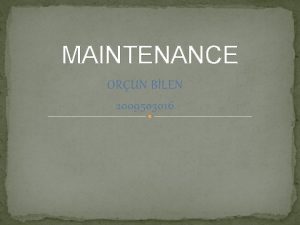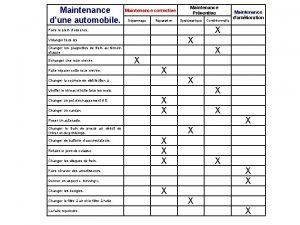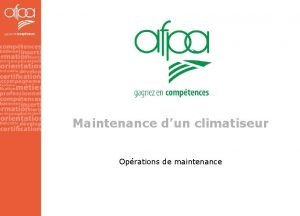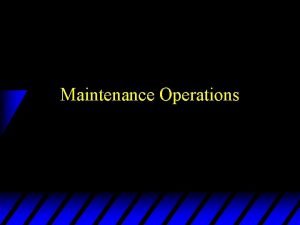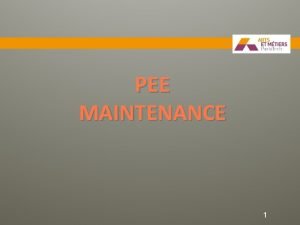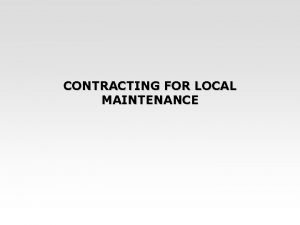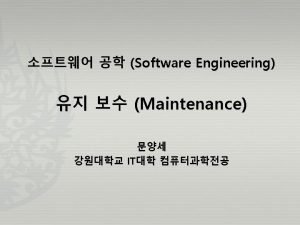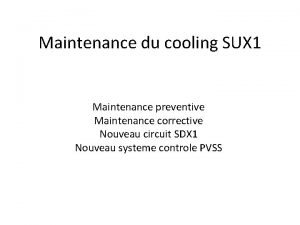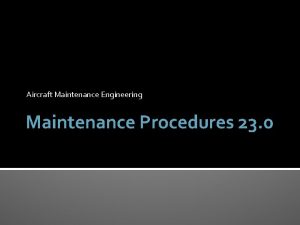lesson 13 1 VEHICLE MALFUNCTIONS Proper maintenance can




























- Slides: 28

lesson 13. 1 VEHICLE MALFUNCTIONS Proper maintenance can prevent most vehicle malfunctions. • A sudden malfunction can create an emergency. Be prepared so you can reduce risk.

OBJECTIVE List actions to take if a tire fails.

Tire Failure Tires wear more quickly due to: • poor maintenance • abrupt braking • sharp steering • bumps • potholes • poor roadway surfaces • unbalanced wheels and poor alignment • underinflation and overinflation

Tire Blowout A blowout occurs when a tire loses air pressure suddenly. A blowout might occur when • a tire hits an object on the roadway or a pothole • the driver fails to maintain proper tire pressure Older and badly worn tires are more likely to blow out.

When a front tire blows out, the vehicle quickly pulls in the direction of the deflated tire. • Steer toward the target and hold firmly against the pull of the vehicle. A left-front tire blowout is especially dangerous, since the vehicle may pull toward the lane of oncoming traffic. What actions would you take to avoid a car with a blowout that was moving into your path of travel?

Handle a rear tire blowout just as you would a skid. 1. Grip the steering wheel firmly. 2. Ease up on the accelerator to slow. Do not brake. 3. Check traffic situation as you gain control of the vehicle. 4. Drive off the roadway slowly to a safe location to stop; braking gently. 5. Turn on hazard flashers.

Changing a Tire The most dangerous aspect of changing a flat tire is finding a safe place to change it. It is important to know how to change a tire. Where can you find information on how to change a tire on your vehicle?

Replace or repair the flat tire as soon as possible. If your spare tire is a temporary or compact spare, drive on it only as necessary under the manufacturer’s conditions for use. The copyright holder has not granted permission to display this photograph in a downloadable format. You may view the photograph in the Drive Right Presentation for this lesson on your Keys to Teaching Success disc.

Many spare tires are called “ 50 -50” tires. This means that the vehicle should not be driven over 50 mph or more than 50 miles. The copyright holder has not granted permission to display this photograph in a downloadable format. You may view the photograph in the Drive Right Presentation for this lesson on your Keys to Teaching Success disc.

OBJECTIVE List the proper steps to follow if the brakes fail.

Brakes The rear and front wheels each have a brake system. If both braking parts fail at the same time, your foot brake will have no braking power. The brake warning light signals a problem with your braking system that needs immediate attention.

Total Brake Failure Total brake failure rarely happens but if it does, it is important that you stay calm. 1. 2. 3. 4. 5. Pump the foot brake pedal. Downshift to a lower gear. Apply the parking brake. Search for a safe place to steer toward. As a last resort, rub the wheels against a curb to reduce speed.

When brakes overheat, they can lose effectiveness. This condition, called brake fade, occurs after continuous hard braking. To regain full braking ability, stop the vehicle and let the brakes cool.

Driving through water can temporarily reduce your brakes’ effectiveness. To dry your brakes: • Gently brake with your left foot as you drive through and leave the water. • Friction will help generate heat to dry your brakes. • Test them after leaving the water to be sure they work normally.

OBJECTIVE Describe what to do in case of engine or steering failure.

Engine Failure Usually you have very little warning that your engine is going to sputter or stop. The vehicle can still be steered with a stalled engine.

If your engine stops suddenly: 1. Shift to NEUTRAL when the engine first sputters or stops. 2. Begin moving out of traffic with your hazard flashers on. Do not brake. 3. Try to restart the engine while you are moving. If the engine starts, shift into a forward gear and proceed. If it does not start, move onto the shoulder or to the curb, if possible. Steering will be harder when power is lost by engine failure.

If your engine fails, turn on the hazard flashers, move safely off the roadway, and raise the hood. If you have a cell phone, call for help. Be sure to stay away from any traffic. The copyright holder has not granted permission to display this photograph in a downloadable format. You may view the photograph in the Drive Right Presentation for this lesson on your Keys to Teaching Success disc.

Stalling on Railroad Tracks If a train is approaching in either direction, abandon the vehicle immediately. Get away from the tracks as far as you can. Running toward the train helps you avoid injury from any flying debris. The copyright holder has not granted permission to display this photograph in a downloadable format. You may view the photograph in the Drive Right Presentation for this lesson on your Keys to Teaching Success disc.

If a train is not approaching, you can try to restart the vehicle. If you cannot restart the engine, have passengers leave the vehicle, put the car in NEUTRAL and push it off the tracks. The copyright holder has not granted permission to display this photograph in a downloadable format. You may view the photograph in the Drive Right Presentation for this lesson on your Keys to Teaching Success disc.

Overheated Engine When the temperature light or gauge is lit: 1. Turn off the air conditioner and turn on the heater. 2. During stops, shift to NEUTRAL and press the accelerator gently. 3. If the temperature light stays on or if the gauge points to hot, move to a safe place. 4. Stop, turn off the engine. Do not add water to the radiator until the engine has cooled.

Total Steering Failure If your steering fails completely, immediately use your horn and hazard flashers to communicate. • Do not use the accelerator. • Braking could cause the vehicle to skid. • Hold the parking brake release and use a quick, on-off action. • Power-steering failure requires you to exert more effort to steer.

OBJECTIVE Explain what to do in case of loss of forward vision and vehicle fires.

Loss of Forward Vision When headlights fail, the hood flies up, or when your windshield gets splashed with dirt, your driving view, or forward vision, is obstructed. Turn on your windshield wipers promptly to regain your forward vision if your windshield gets splashed. Check your rear zone. The copyright holder has not granted permission to display this photograph in a downloadable format. You may view the photograph in the Drive Right Presentation for this lesson on your Keys to Teaching Success disc.

If your headlights flicker, use your right turn signal and move to the right shoulder of the road. You can activate the dimmer switch, parking lights, and hazard flashers, as some circuits might still work. Check fuses or fuse clips.

Vehicle Fires Most vehicle fires start in the engine. If your car suddenly starts to smoke: 1. Quickly steer the vehicle off the roadway to a safe, open area. 2. Have passengers move at least 100 feet away from the vehicle. 3. Leave the hood closed and do not try to put out the fire. 4. Move away from the vehicle while you wait for the fire department.

A passenger-compartment fire is usually caused by a careless smoker. Pull off the roadway immediately and use water or a fire extinguisher and make sure the fire is completely out. Upholstery fires often restart, sometimes even hours later. Fire is possible in any collision where the engine compartment is smashed. Turn off the ignition and get passengers out and away from the vehicle.

lesson 13. 1 review 1. As a driver, what can you do to minimize the risk of tire failure? 2. Why is it important not to brake if you have total steering failure?
 Curriculum guide for driver education in virginia module 10
Curriculum guide for driver education in virginia module 10 If your vehicle malfunctions, turn on your hazard lights
If your vehicle malfunctions, turn on your hazard lights Nucleolus function
Nucleolus function Aorta vena cava
Aorta vena cava Tendons function
Tendons function Cosmic superclass in java
Cosmic superclass in java Who has defined style as: 'proper words in proper places?
Who has defined style as: 'proper words in proper places? Chapter 9 vehicle maintenance fluid service and recycling
Chapter 9 vehicle maintenance fluid service and recycling Fmcsa record retention & recordkeeping basics
Fmcsa record retention & recordkeeping basics Vehicle maintenance fluid service and recycling
Vehicle maintenance fluid service and recycling Proper abstract nouns
Proper abstract nouns Vehicle extrication lesson plan
Vehicle extrication lesson plan Proper noun images
Proper noun images Grammar unit 2
Grammar unit 2 If you can imagine it you can achieve it
If you can imagine it you can achieve it You can tell harris about it just ____(easily) as i can.
You can tell harris about it just ____(easily) as i can. If you think you can you can poem
If you think you can you can poem If you can not measure it you can not improve it
If you can not measure it you can not improve it If you can't measure it you can't manage it
If you can't measure it you can't manage it Percussions corporelles
Percussions corporelles The arrangement of the element of curriculum is
The arrangement of the element of curriculum is You can tell harris about it just ____(easily) as i can
You can tell harris about it just ____(easily) as i can How to be more impressive 1+1=2
How to be more impressive 1+1=2 I can could speak english
I can could speak english Look at the pictures and complete with can or can't
Look at the pictures and complete with can or can't Dr jean cool bear hunt
Dr jean cool bear hunt Through you nothing is impossible
Through you nothing is impossible You can t manage what you can t measure
You can t manage what you can t measure Already can or can already
Already can or can already

